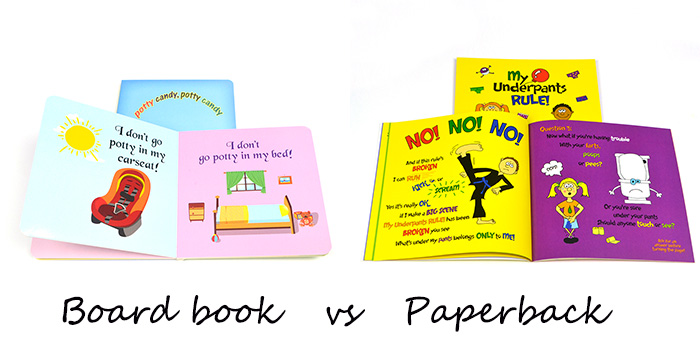Board book and paperback are both popular type of printing used for children's books and other publications. Whether as parents or author, select a right book type is the key. In this article, we will from parent's and author's view, guide you how to choose the best book type.

For parents, board book and paperback: how to choose?
As a new parent, grandparent, or caregiver, choosing the right type of book for your child can be a daunting task. There have so many options available in the book market, it is very hard to know where to start. One decision that parents often face is whether to choose a board book or a paperback book for their child. Here are listed some factors for parents to refer before making a decision:
Durability:
Durability is one of the biggest advantages of board books. They are designed to withstand rough handling, drool, and spills, which is important for young children who are still learning to handle books carefully. Paperback books, on the other hand, are more fragile and are more likely to tear or bend if mishandled. If you are purchasing a book for a very young child, then a board book may be a better choice due to its sturdiness.
Cost:
Board books are generally more expensive than their paperback counterparts, due to the thicker pages and sturdier binding. Many board books are also published in smaller print runs, which can drive up the cost even more. If cost is a concern, then a paperback book may be a more budget-friendly option.
Content:
The content of the book is also need to consider. Board books are typically designed for young children, with simple stories, bright colors, and minimal text. Paperback books, on the other hand, can cover a wider range of topics and are often written for older children. If you are looking for a book with a specific message or topic, then a paperback book may be a better choice.
Artwork:
The type of artwork in the book is another consideration. Board books often have simple illustrations with bold colors and high contrast to catch the attention of young children. Paperback books, on the other hand, may have more detailed illustrations with a wider range of colors and shading. If you are looking for a book with complex and detailed illustrations, then a paperback book may be a better choice.
Size:
Finally, the size of the book is an important consideration. Board books are often smaller in size and have fewer pages than paperback books. This makes them easier for young children to hold and handle. Paperback books, however, can be larger and have more pages, which may be more appropriate for older children. If you are purchasing a book for a very young child, then a smaller board book may be more appropriate.
Overall, the choice between a board book and a paperback book ultimately depends on your child's age, the content of the book, and your budget. Board books are more durable and designed for very young children, while paperback books are more diverse in content and artwork. Consider these factors when making your decision, and choose the type of book that best fits your child's needs and interests.
For author, board board vs paperback: which is suit for your book?
For author, printing is an important consideration when it comes to publishing children's books. Among the most popular formats are board books and paperbacks, which use different printing processes.
Board Book Printing
Board books are designed with thick cardboard pages, making them a popular choice for infants and toddlers, as they can withstand rough handling and are easy to clean. Board book printing typically involves a process known as offset printing, which involves creating templates for each page, using plates to transfer the design onto the card, and cutting the pages to the required size.
This process results in a high-quality product, with bright, vivid colors and sharp images. However, it is a more labor-intensive and expensive printing process than paperback printing.
Paperback Printing
Paperback books are typically printed using digital printing technology or a process known as offset printing. Digital printing is a fast and cost-effective printing method, which involves transferring the design directly onto the paper using digital files.
Offset printing, on the other hand, involves printing a continuous roll of paper and cutting it to size. This method is ideal for large print runs and produces high-quality products at a lower cost.
Choosing the Right Format
When choosing between board book printing and paperback printing, publishers should consider factors such as cost, target audience, and intended use.
If the book is aimed at young children, board book printing is a more suitable option, as it is durable and long lasting. For books aimed at older children or adults, paperback printing is generally more appropriate.
Additionally, the intended use of the book should be considered. If the book is primarily for entertainment, then paperbacks may be more suitable. However, if the book is intended for educational purposes, board book printing may be the better option.
In conclusion, both board book printing and paperback book printing have their advantages and disadvantages. The choice of which format to use depends on the intended use, budget, and target audience. Ultimately, both formats can produce high-quality products that meet the specific needs of children readers. If you also want to learn about the difference between board book and hardcover, please click "board book vs hardcover" this post.

